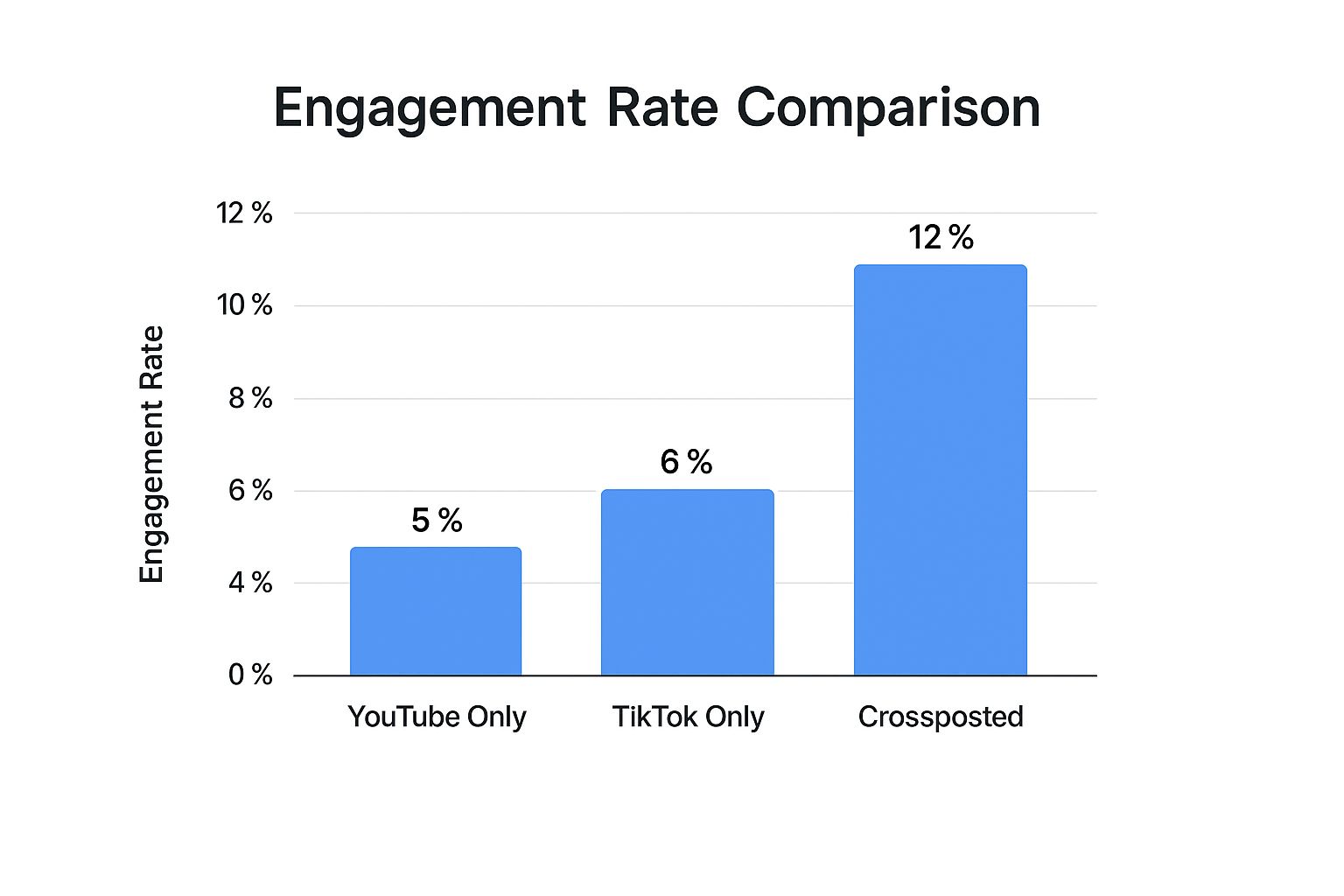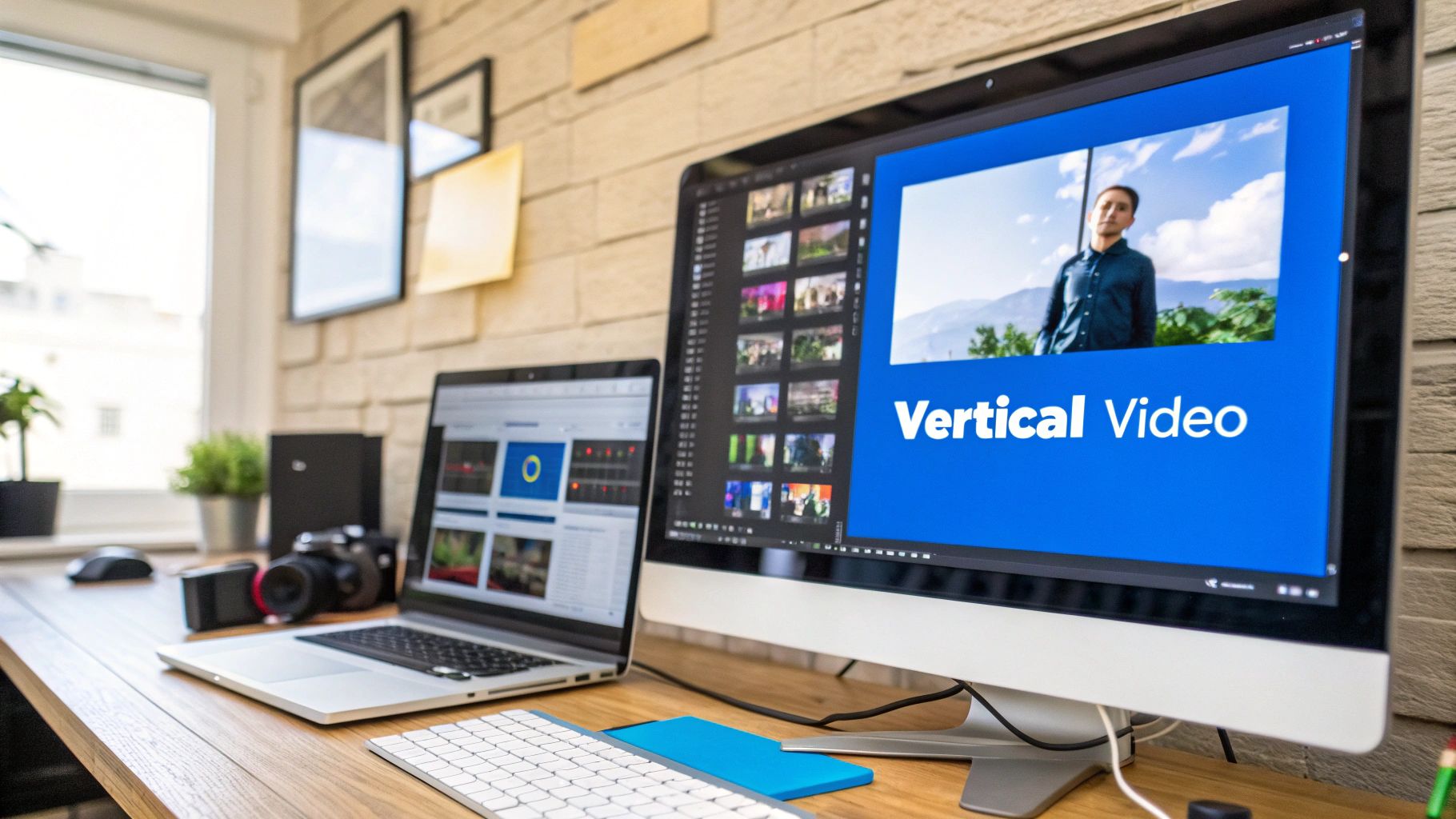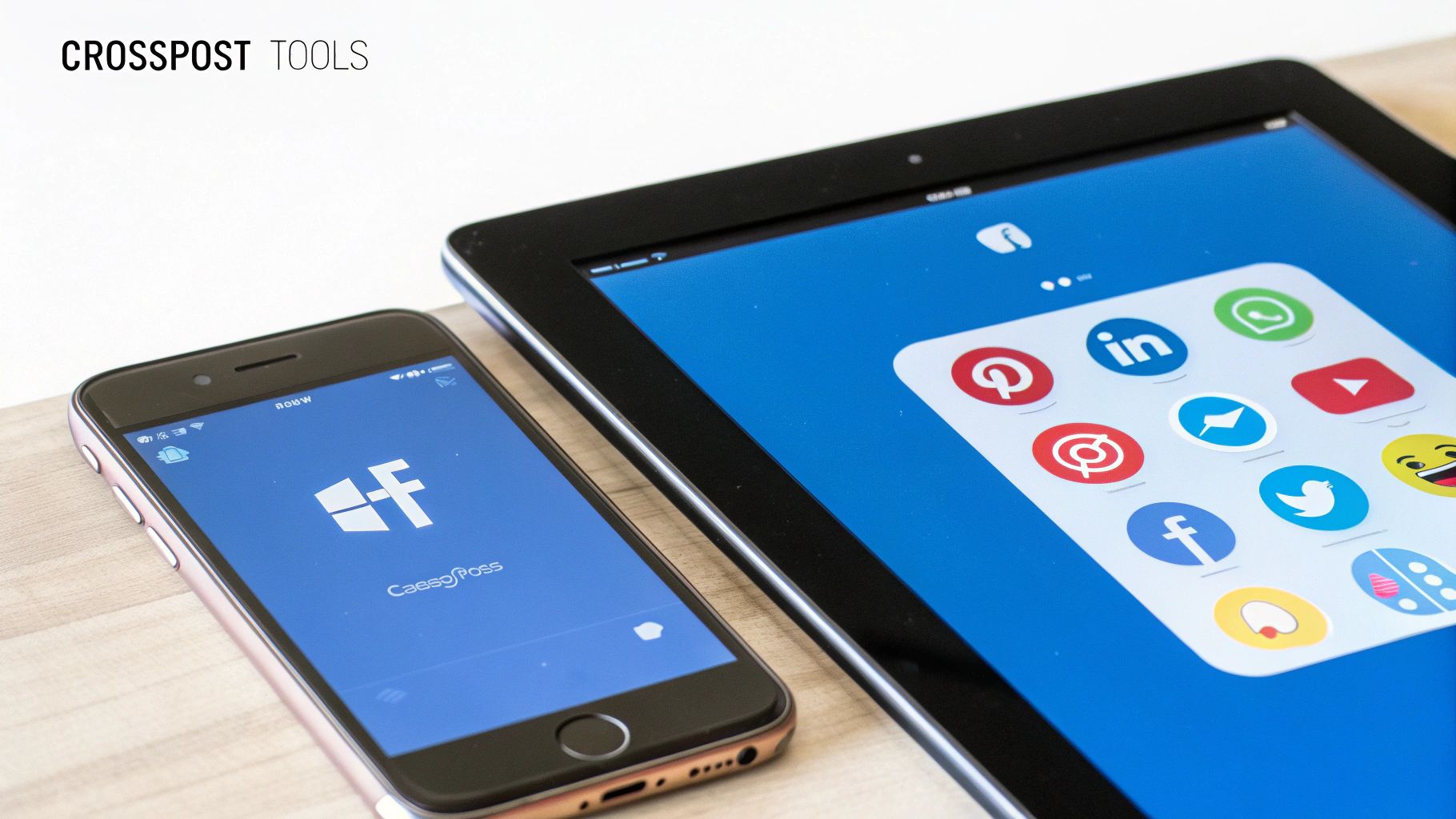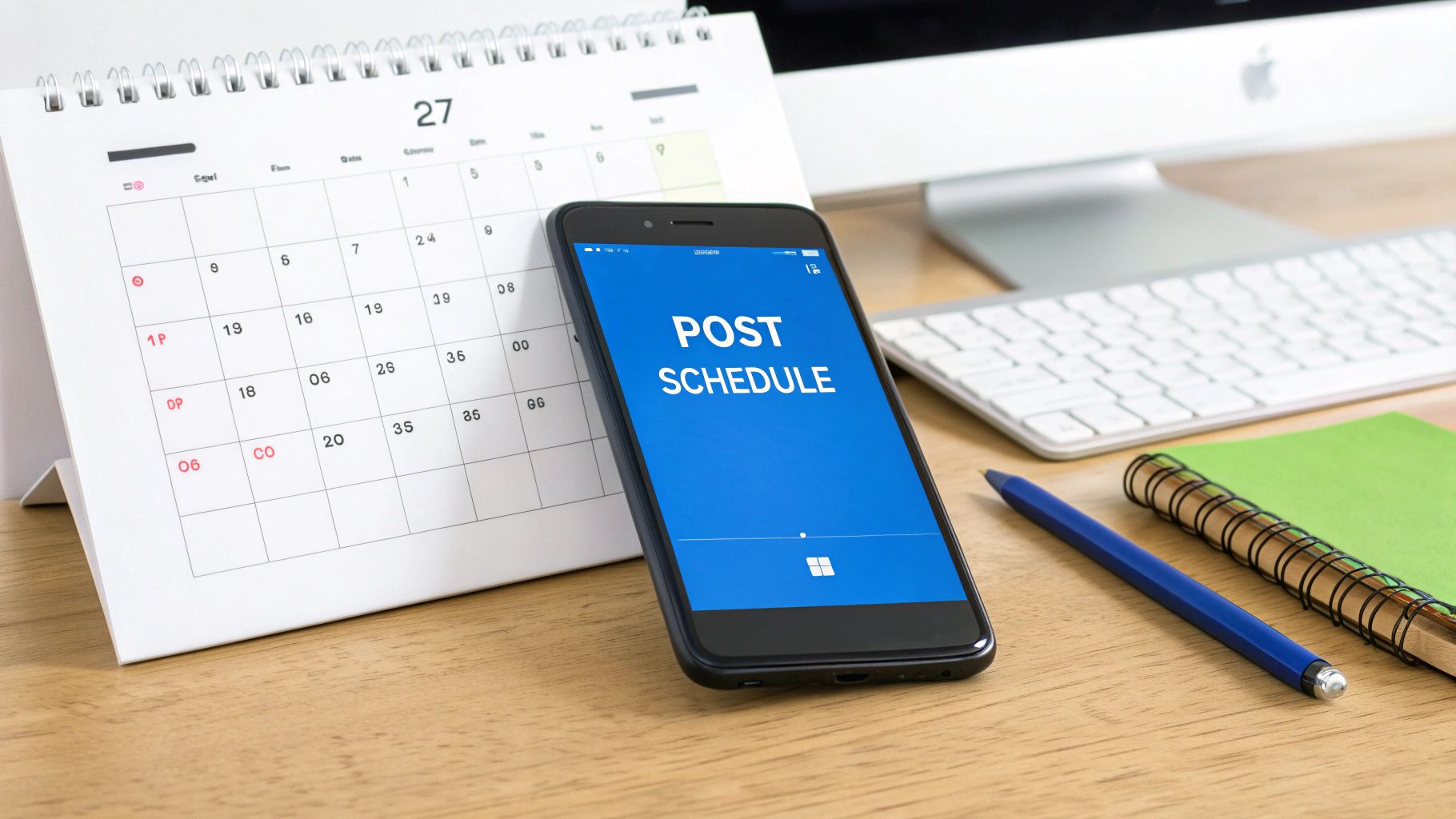Why Smart Creators Are Going Multi-Platform (And You Should Too)
Relying solely on one platform for content creation isn't advisable. Depending on a single site makes you vulnerable to changes in algorithms, unexpected downtimes, and shifting audience preferences. A multi-platform strategy reduces these risks and provides avenues for growth.
Consider a YouTuber whose videos are suddenly demonetized due to a policy update. If they've also cultivated an audience on TikTok, they have an alternative plan and another revenue channel, showcasing the stability a multi-platform strategy offers.
Crossposting content between platforms like YouTube and TikTok helps creators access diverse audiences. While some overlap exists, each platform attracts distinct demographics with unique viewing habits. TikTok often draws a younger crowd who enjoy short, trendy content, whereas YouTube appeals to a wider audience with longer, more detailed videos.
Crossposting is not about merely replicating content; it's about modifying your message to fit the culture of each platform. This practice is gaining traction, with YouTube Shorts generating 70 billion daily views globally. Industry surveys reveal that over 60% of video-first creators now engage with at least two platforms. Find more detailed statistics here You might also find this resource helpful: How to master crossposting on TikTok.
Understanding the Benefits of a Multi-Platform Approach
Reaching a broader audience is just one benefit. Here are more reasons why creators are adopting a multi-platform strategy:
-
Increased Brand Awareness: Being present on multiple platforms reinforces your brand identity and enhances recognition among potential followers.
-
Improved Content Discoverability: Each platform has its own algorithms and discovery processes, increasing the chances of your content being noticed and shared widely.
-
Enhanced Audience Engagement: Adapting your content for each platform's audience builds stronger connections and helps foster a loyal following.
-
Diversified Income Streams: Each platform offers different monetization options, enabling you to diversify your income and lessen dependence on a single source.
Tailoring Your Content for Crossposting Success
Here are some best practices for effectively adapting your content:
-
Optimize Video Length: Trim longer YouTube videos into shorter clips suitable for TikTok.
-
Add Captions and Text Overlays: This caters to viewers watching without sound, a common habit on platforms like TikTok.
-
Use Trending Sounds and Hashtags: Employ trending audio and relevant hashtags to enhance discoverability on platforms like TikTok.
-
Engage with Comments: Responding to comments helps build community and fosters interaction on both platforms.
By understanding each platform's nuances and adjusting your content accordingly, you can expand your reach and unlock growth opportunities.
Tools That Actually Work (And Which Ones Don't)
Finding effective tools to crosspost from YouTube to TikTok can be tricky. Many platforms claim seamless integration and easy automation but often don't deliver. This section provides an honest look at tools that are effective.
Automation Platforms: Simplifying Your Workflow
For creators seeking automation in crossposting, several platforms offer useful features and varying degrees of control. A top choice is PostOnce.to, which provides automated crossposting, scheduling tools, and supports a variety of platforms like Threads and BlueSky. It simplifies the process and ensures content appears polished across platforms. Learn more about the features here.
Manual Crossposting: Maintaining Hands-On Control
While automation is convenient, some creators prefer manual crossposting. This involves downloading videos from YouTube and separately uploading them to TikTok, allowing for detailed adjustments to titles, descriptions, and hashtags. This method offers greater flexibility in customizing content for each platform's audience but requires more time and effort.
Evaluating Crossposting Tools: Key Considerations
Whether you choose automation or manual methods, consider these factors when evaluating tools or techniques:
-
Video Quality: Does the tool maintain video resolution and aspect ratio?
-
Platform Integration: How seamlessly does the tool integrate with YouTube and TikTok?
-
Customization Options: Can you adjust titles, descriptions, and hashtags for each platform?
-
Scheduling Capabilities: Does the tool offer scheduling for automated posting?
-
Pricing and Value: Does the tool's price match its features and benefits?
To assist in selecting the right tool, we've compiled a comparison of popular crossposting options. This table outlines key features, supported platforms, upload limits, and pricing.
Top Crossposting Tools Comparison
This table provides a detailed look at the features, pricing, and capabilities of leading crossposting platforms.
Tool Name | Platforms Supported | Daily Upload Limit | Pricing | Key Features |
|---|---|---|---|---|
PostOnce.to | Threads, X (Twitter), BlueSky, TikTok | Varies based on plan | Starts at $9/month | Automated crossposting, scheduling tools |
Repurpose.io | YouTube, TikTok, Instagram, Facebook, etc. | Varies based on plan | Starts at $35/month | Automated crossposting, video editing, scheduling |
Buffer | TikTok, Instagram, Facebook, Twitter, LinkedIn, Pinterest | Varies based on plan | Starts at $6/month per account connected | Scheduling, analytics, engagement tools |
Later | Instagram, TikTok, Pinterest, Facebook, Twitter | Varies based on plan | Starts at $18/month | Scheduling, visual content planning, hashtag tools |
This comparison highlights the various options for crossposting. PostOnce.to offers support for a wide range of platforms, including Threads and BlueSky. Buffer is designed for scheduling and analytics, while Later specializes in visual content planning and hashtag analysis. Choosing the right tool will depend on your specific needs and budget.
Measuring the Impact of Crossposting

This chart compares engagement rates for content posted exclusively on YouTube, exclusively on TikTok, and crossposted on both. A combined approach yields significantly higher engagement. Crossposting resulted in a 12% engagement rate, outperforming the 5% and 6% rates seen on YouTube and TikTok alone. This underscores the potential of crossposting to amplify reach and impact. By understanding each platform's strengths and using the right tools, creators can expand their online presence.
Cracking The Algorithm Code On Both Platforms

Crossposting content from YouTube to TikTok isn't just about uploading the same video twice. It requires a nuanced understanding of what appeals to each platform's unique audience. Think of it as adjusting your communication style – the core message stays the same, but the delivery changes to effectively connect with different audiences. Both platforms prioritize distinct types of content and creator behaviors.
TikTok: The Discovery Engine
TikTok thrives on a constant stream of fresh content. The algorithm prioritizes showing videos to new viewers, consistently pushing content to a broader audience. This means captivating visuals, trending sounds, and engaging hooks are essential for grabbing attention quickly. Think short, snappy, and visually compelling. Hashtags also play a vital role in discoverability, guiding the algorithm toward the right audience segments.
YouTube Shorts: The Engagement Hub
YouTube Shorts, while similar in format, operates on a different principle. Engagement is paramount here. The algorithm prioritizes videos with high watch times, likes, comments, and shares. Building a community around your content becomes more important than simply reaching new viewers with each upload. This means focusing on creating content that sparks conversation and encourages interaction. While TikTok seeks to constantly expand reach, YouTube Shorts focuses on cultivating dedicated viewership.
This distinction is crucial for crossposting. TikTok's algorithm prioritizes content that attracts new viewers (ideally over 90% new viewership), while YouTube Shorts focuses on rapid engagement and discovery within a potentially smaller, yet more dedicated, audience. This makes each platform’s audience slightly different, creating a complementary relationship for crossposted content. Learn more about growing your YouTube audience here.
Adapting Your Content: A Balancing Act
Successfully crossposting YouTube content to TikTok requires understanding these core differences. For example, a YouTube Short with a longer introduction might perform well on YouTube, but could lose viewers on TikTok who expect instant gratification. Conversely, a TikTok video heavily reliant on trending sounds might feel out of place on YouTube Shorts. For efficient cross-platform posting, explore the Features of tools like PostOnce.
You might also find this helpful: How to master crossposting on social media. Adapting your content involves making strategic adjustments to titles, descriptions, and hashtags. Consider A/B testing different versions to identify what resonates best with each audience. Experiment with shorter cuts for TikTok, add text overlays for viewers watching without sound, and adjust your calls to action according to platform conventions. The goal is to maintain the core value of your content while optimizing its presentation for both platforms, creating variations that resonate with each unique audience without feeling repetitive to those who follow you on both YouTube and TikTok.
Numbers That Matter (And Vanity Metrics To Ignore)
Crossposting YouTube content to TikTok can sometimes feel like an obsession with numbers. However, simply chasing vanity metrics like views and likes won't create a lasting online presence. Instead, concentrate on key performance indicators (KPIs) that reveal authentic audience growth and engagement across both platforms. This involves understanding which metrics actually predict long-term success and which ones offer only a fleeting sense of accomplishment.
Beyond Likes and Views: Measuring What Matters
While likes and views offer a surface-level look at performance, they don't tell the whole story. Engagement rate, determined by dividing total engagements (likes, comments, shares) by your reach, offers a more precise measurement of how your audience interacts with your content. Audience overlap shows how many followers engage with your content on both YouTube and TikTok, indicating how effective your crossposting strategy is. Conversion rates, such as click-throughs to your website or product purchases, demonstrate how crossposting influences your broader business goals. For helpful advice on creating viral YouTube Shorts, check out this resource: Generate Youtube Shorts Like A Pro From Zero To Viral.
Looking beyond superficial metrics, consider average watch time on YouTube Shorts and video completion rate on TikTok as crucial indicators of whether your content truly resonates with your audience. These metrics show if viewers are genuinely interested in your videos or just passively scrolling by. Analyzing these data points gives you a much clearer understanding than simply looking at surface-level vanity metrics. This deeper understanding can then help you refine your content strategy and optimize your crossposting approach for maximum results.
Setting Realistic Benchmarks: Avoiding Comparison Traps
It’s easy to fall into the trap of comparing your performance to that of mega-influencers. Remember, benchmarks should be relative to your own individual creator level. A smaller creator with a highly engaged audience might actually be outperforming a larger creator with low interaction. Based on 2025 statistics, short-form video engagement has seen a significant increase, with crossposting contributing to a 20-30% growth in audience overlap between YouTube Shorts and TikTok for active creators. The use of crossposting tools like PostOnce has also risen sharply, with over 500,000 registered users on such platforms. You can explore more detailed statistics here: Discover more insights about TikTok statistics.
Tracking your own progress over time is essential to identifying trends and measuring the effectiveness of specific content or strategies. This helps you set realistic goals and recognize incremental improvements. Sustainable growth is a long-term endeavor, not a quick win. Focus on cultivating a loyal audience and creating content that truly connects with your niche. This approach, along with consistent crossposting and data-driven adjustments, sets the foundation for long-term success.
To understand what to track, take a look at the following table:
Key Performance Metrics for Crossposting
Essential metrics to track for measuring crossposting success across YouTube and TikTok
Metric | YouTube Shorts | TikTok | Crossposting Impact | Success Benchmark |
|---|---|---|---|---|
Engagement Rate | Likes, Comments, Shares / Reach | Likes, Comments, Shares / Reach | Increased interaction on both platforms | >2% (Varies by niche) |
Audience Overlap | Number of followers on both platforms | Number of followers on both platforms | Indicates crossposting effectiveness | 20-30% growth for active creators |
Conversion Rate | Click-throughs, Purchases | Click-throughs, Purchases | Measures impact on business goals | Varies by campaign |
Average Watch Time | Seconds watched per video | Not directly comparable, but relates to video completion rate | Shows content resonance | Aim for highest possible within platform averages |
Video Completion Rate | Percentage of video watched | Percentage of video watched | Indicates content captivation | Aim for highest possible within platform averages |
This table summarizes key performance metrics to track when crossposting content between YouTube Shorts and TikTok. Analyzing these metrics can provide valuable insights into audience engagement, cross-platform effectiveness, and the overall impact of your crossposting strategy. Remember to set realistic benchmarks based on your individual creator level and track progress over time to identify trends and optimize your approach.
Advanced Content Adaptation That Actually Works

Crossposting YouTube content to TikTok isn't just about uploading the same video. It requires a nuanced understanding of each platform's audience and algorithm. The real challenge lies in creating content that feels organic to each platform while maintaining your brand identity.
Mastering Platform-Specific Storytelling
Imagine each platform as a unique stage. Your performance needs to adapt to connect with the specific audience. TikTok, known for its short-form video format, thrives on quick, engaging content using trending sounds and visuals. YouTube Shorts, while similar, often allows for slightly longer videos with more developed narratives and engagement opportunities.
A fast-paced, visually driven TikTok video might excel on that platform but could feel incomplete on YouTube Shorts. Conversely, a YouTube Short with a longer introduction might perform well on YouTube but lose viewers on TikTok who expect immediate engagement.
Advanced Editing Strategies for Crossposting
Adapting YouTube videos for TikTok calls for strategic editing. Create shorter cuts of your YouTube content, focusing on key moments or impactful takeaways. Add text overlays and captions for viewers who watch without sound, a common practice on TikTok. Experiment with trending sounds and music that complement TikTok trends without compromising your brand's voice.
Don't forget platform-specific features. TikTok's duets and stitches offer unique avenues for audience interaction and content repurposing. YouTube Shorts' seamless integration with longer-form YouTube content offers opportunities to drive traffic between the two. Mastering these details ensures your content feels genuinely integrated within each platform.
Optimizing for Timing and Authenticity
Understanding optimal posting times for each platform is crucial. Research peak engagement periods for your target audience on both YouTube and TikTok. Strategic scheduling maximizes visibility. PostOnce simplifies this with streamlined scheduling features, helping you reach the right audience at the right time.
Finally, maintain authenticity. While adapting to different platform styles is important, avoid trends that don't align with your brand values. Your core message should remain consistent, even if the delivery method changes. This builds trust and loyalty with followers who discover you across multiple channels. This consistent approach creates a recognizable and unified online presence that strengthens your brand identity regardless of platform.
Building Systems That Scale With Your Growth

Successfully crossposting YouTube content to TikTok requires a strategic approach that goes beyond occasional uploads. As your audience expands, your systems need to adapt to handle the increased content volume without leading to creator burnout. Successful creators recognize this and prioritize building sustainable workflows.
Content Planning and Production: Creating a System
Managing a multi-platform presence demands a structured approach. Begin by developing a content calendar that outlines planned videos for both YouTube and TikTok. This calendar should detail topics, target keywords for improved discoverability, and scheduled publishing dates. Pre-planning enables a more strategic approach to content creation and crossposting, saving valuable time and preventing last-minute rushes.
Consider using a template to streamline your content planning process. This could be a simple spreadsheet or a more robust project management tool like Asana, depending on your needs. The template should include fields for video titles, platform-optimized descriptions, relevant TikTok hashtags, and any necessary edits for adapting YouTube content to TikTok's format.
For instance, a lengthy cooking tutorial on YouTube could be condensed into a shorter, visually engaging recipe video for TikTok. This allows you to repurpose existing content efficiently while catering to the specific preferences of each platform's audience.
Distribution and Automation: Scaling Your Efforts
As your content output grows, automation becomes crucial. Tools like PostOnce enable seamless content scheduling and crossposting. PostOnce handles platform-specific formatting, such as text length and video dimensions, ensuring your content appears polished on both platforms without manual adjustments for each upload. This automation frees you to concentrate on content creation, audience engagement, and other strategic activities.
Furthermore, PostOnce simplifies managing multiple accounts, allowing you to oversee both your YouTube and TikTok presence from a central dashboard. This consolidated approach becomes especially valuable as your channels expand and demand more complex management strategies.
Team Collaboration: Expanding Your Reach
If your crossposting operation grows to involve a team, implement clear workflows and communication channels. Assign specific roles for content creation, editing, scheduling, and performance analysis. This structured approach keeps everyone on the same page and ensures consistent quality across both platforms.
Regular team meetings are vital for discussing content strategy, analyzing performance data, and brainstorming new ideas. This collaborative approach helps you maintain consistency and adapt your strategy as platforms evolve and audience preferences shift. This also means staying ahead of trends by experimenting with new platform features and adjusting your approach accordingly.
Your Crossposting Action Plan
Now it's time to create a structured plan for your crossposting efforts. This section provides a clear roadmap to implement your strategy, focusing on actionable steps you can take right away.
Setting Up Your Crossposting Workflow
The first decision is whether you'll use automation tools or handle things manually. Automation platforms like PostOnce offer the convenience of scheduling content across various platforms, including YouTube and TikTok. This is especially beneficial given YouTube's partnership with PostOnce, making for a more streamlined cross-platform experience. However, some creators may prefer manual uploads for greater control.
Regardless of your chosen method, establishing a content calendar is essential. A content calendar brings organization and consistency to your posting schedule, ensuring a steady stream of content reaches both platforms. For further guidance on crossposting, check out this helpful resource: How to master social media cross-posting.
Here’s a simple workflow to get you started:
-
Step 1: Choose your crossposting method (automation or manual).
-
Step 2: Create a content calendar outlining planned videos for YouTube and TikTok.
-
Step 3: If using automation, set up your chosen platform (e.g., PostOnce) and connect your accounts.
-
Step 4: Prepare your videos for each platform, optimizing titles, descriptions, and hashtags.
Maintaining Quality While Scaling
As your audience grows, maintaining content quality is paramount. Develop a checklist to ensure consistent standards across all your videos. This checklist might include verifying correct video dimensions, adding captions for TikTok viewers, and incorporating relevant hashtags.
This process guarantees that as you expand your content's reach, the quality that attracted your initial audience remains intact. Remember, adapting your content to the specific audience of each platform is crucial for success.
Tracking Your Progress: Measuring What Matters
Focus on meaningful metrics that provide valuable insights, rather than just vanity numbers. Track metrics like engagement rate, audience overlap between platforms, and any conversion rates relevant to your goals.
These data points will inform necessary content adjustments and help refine your overall strategy. You can use a simple spreadsheet or dedicated analytics tools to monitor progress. Regular reviews will help identify areas for improvement and keep you moving forward.
Here's a breakdown of key metrics to track:
-
Metric: Engagement Rate. How to track: Total Engagements (likes, comments, shares) / Reach.
-
Metric: Audience Overlap. How to track: Number of followers engaging with your content on both YouTube and TikTok.
-
Metric: Conversion Rate. How to track: Click-throughs to your website or other desired actions.
By following a structured action plan, you can effectively crosspost your YouTube content to TikTok, maximizing your reach and building a thriving presence on both platforms. Ready to streamline your social media? Get started with PostOnce today!